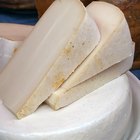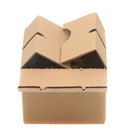
Though you are unlikely to become rich from recycling cardboard, you may be able to earn some additional spending money by turning in your old boxes or scraps to certain recycling centers.
Not every recycling center will buy your used cardboard, so make sure to call ahead to your local center before making the trip to drop off your materials.
Once you've confirmed a location that offers this service, you'll want to keep a few important things in mind to make the process go as smoothly as possible.
1. Discard Any Wet or Dirty Cardboard
If the material has been soaked by water or soiled by food waste, throw it into the trash instead of trying to recycle it. According to Recycle Across America, a nonprofit dedicated to expediting environmental progress, pizza boxes are a common culprit. If your pizza box has been contaminated with oil, cheese and sauce, you can try composting the box. If the box contains any plastic, though, you are better off sending it to a landfill.
2. Remove All Packing Materials
Remove any non-cardboard component, such as string, plastic ties, staples, bubble wrap or packing peanuts. While these other materials may be recyclable on their own, they must be separated from the cardboard before the recycling center will accept it.
According to the American Forest & Paper Association, you do not need to remove any tape or labels from your boxes, as these materials are removed during the recycling process.
3. Flatten Cardboard Boxes
Break down any boxes by unfolding the flaps and fully collapsing the material. You may also opt to cut large boxes to a smaller, more manageable size for weighing and transport.
4. Stack Your Cardboard on a Scale
Stack all of your cardboard on a digital scale to obtain its weight in pounds. A normal household scale may suffice as long as you have enough cardboard to reach your scale's minimum weight.
If you have a large amount of cardboard that won't fit on a household scale, you can weight the material with a pallet truck that has a scale, according to Recycling.com. This industrial tool is used to easily lift and move around heavy loads, and the built-in digital scale makes it easy to get the accurate weight of those loads.
You can also use a platform scale to weight your material, which tends to be more accurate, according to the site. Make sure this floor scale is on a flat, level surface for the most accurate reading.
5. Call Ahead for Rates
Find out the recycling center's rate for recycled cardboard. Most rates will be in tons. Divide the price per ton by 2,000 to find the price per pound. The typical price for recycled cardboard is between 1/2 cent and 3 cents per pound, but this will vary by center.
It's a good idea to tell the recycling center how much cardboard you have before you bring it in because some centers will only recycle cardboard above a minimum weight.
Related Articles

What Items Can't Be Recycled?

How to Make Cakes With Candy Baked ...

Can I Bake Cupcakes in Teacups?

List of Biodegradable, Every Day ...

What Are the Uses of Vermicompost?

Types of Paper That Cannot Be Recycled

How to Buy Play-Doh in Bulk

Recycling Aluminum Tabs Vs. Cans

How to Keep Chocolates Cool When ...

What Types of Foam Can Be Recycled?

How to Replace a Lost Canadian Birth ...

Advantages of Vermicompost

How to Make a Dutch Cheese Press

Advantages of Paper Bags vs. Plastic ...

Cellophane vs. Polypropylene

The Disadvantages of Vermicompost

Plastic Recycling Levels

USPS Fragrance Oil Shipping Label ...
How to Measure Fondant

How to Calculate Shipping Volume
References
Writer Bio
Brian Richards is an attorney whose work has appeared in law and philosophy journals and online in legal blogs and article repositories. He has been a writer since 2008. He holds a Bachelor of Science in psychology from University of California, San Diego and a Juris Doctor from Lewis and Clark School of Law.
Photo Credits
recycled cardboard image by Gale Distler from Fotolia.com